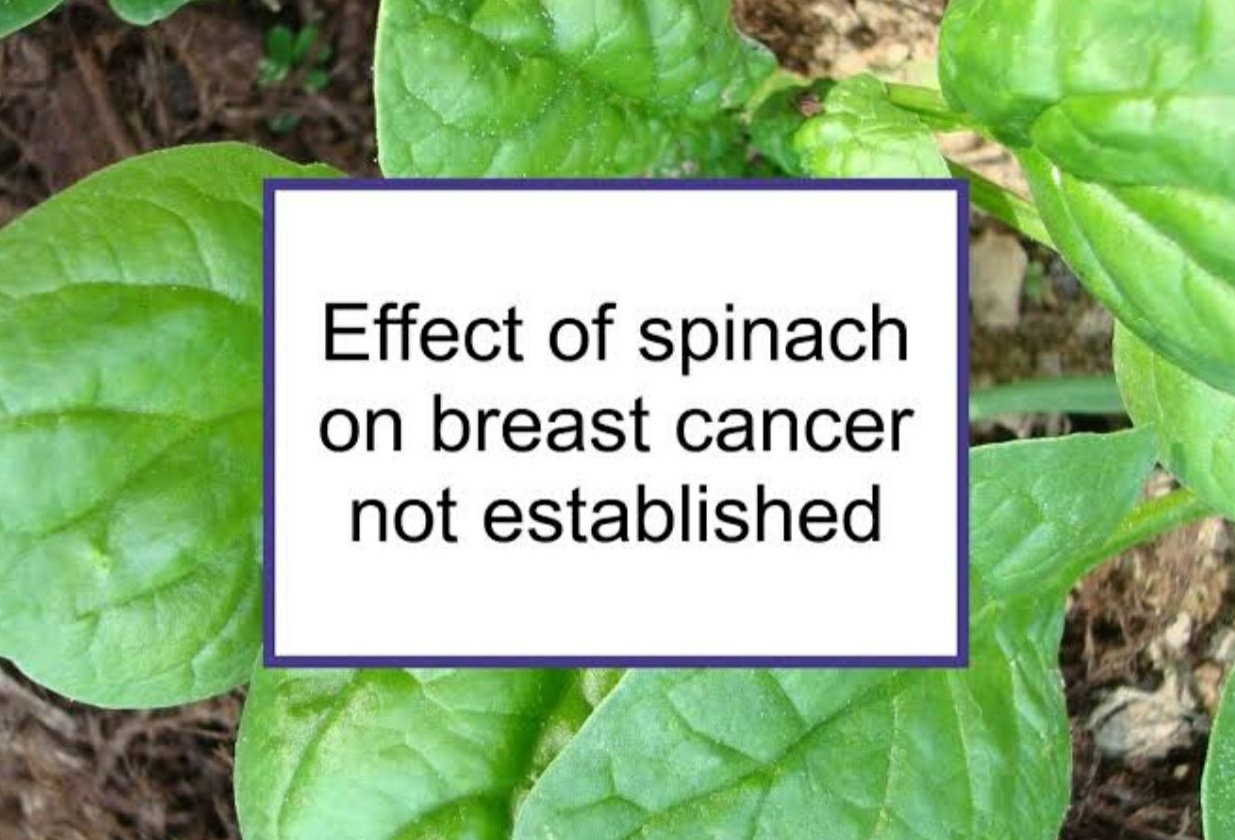Spinach (Spinacia oleracea) is a leafy green flowering plant native to Central and Western Asia. It is of the order Caryophyllales, family Amaranthaceae, subfamily Chenopodioidease. Its leaves are a common edible Vegetable consumed either fresh, or after storage using preservation techniques by canning, freezing, or dehydration. It may be eaten cooked or raw, and the taste differs considerably; the high oxalate content may be reduced by steaming.

It is an annual plant (rarely biennial), growing as tall as 30 cm (1 ft). Spinach may overwinter in temperate regions. The leaves are alternate, simple, ovate to triangular, and very variable in size: 2-30 cm (1-12 in) long and 1-15 cm (0.4-5.9 in) broad, with larger leaves at the base of the plant and small leaves higher on the flowering stem. The flowers are inconspicuous, yellow-green, 3-4 mm (0.1 – 0.2 in) in diameter, and mature into a small, hard, dry, lumpy fruit cluster 5-10 mm (0.2 – 0.4 in) across containing several seeds.

In 2018, world production of spinach was 26.3 million tonnes, with China alone accounting for 90% of the total.
HEALTH BENEFITS AND NUTRITIONAL VALUE OF SPINACH
Spinach is a superfood. It is loaded with tons of nutrients in a low-calorie package. Dark, leafy green like spinach are important for skin, hair, and bone health. They also provide protein, iron, vitamins, and minerals.
The possible health benefits of consuming spinach include improving blood glucose control in people with diabetes, lowering the risk of cancer, and improving bone health, as weell as supplying minerals and vitamins that can provide a range of different.

Spinach has been used by various cultures throughout history, notably in Mediterranean, Middle-Eastern, and south-East-Asian cuisine. It can be incorporated quite easily into any diet, as it is cheap and easy to prepare.
This article explores the nutrition contained in spinach, how it can benefit the body, and a range of flavorsome ways to include this in the diet.
FAST FACTS ON SPINACH

● According to the United States Department o f Agriculture (USDA), a 100 – gram serving of spinach contains 28.1 micrograms of vitamin C, 34 percent of the daily recommendation.
● Different types include savoy spinach, flat spinach, and semi-savoy spinach.
Spinach can be added as an ingredient to many dishes and either cooked or served raw.
NUTRITION

One cup of raw spinach contains:
● 7 calories
● 0.86 grams (g) of protein
● 30 milligrams (mg) of calcium
● 0.81 g of iron
● 24 mg of magnesium
● 167 mg of potassium
● 2,813 international units (UI) of Vitamin A
● 58 micrograms of folate
Spinach also contains vitamin K, fiber, phosphorus, and thiamine. Most from protein and carbohydrates.

IRON
A lack of iron in the diet can affect how efficiently the body uses energy. Spinach is a great source of iron. Make sure to combine vitamin-C-rich foods such as citrus fruits with plant iron like spinach to improve absorption.
CALCIUM
Spinach contains approximately 250 mg of calcium per cup. However, it is less easily absorbed than calcium obtained from dairy sources. Spinach has a high oxalate content, which binds to calcium. This makes if difficult for our bodies to use.

MAGNESIUM
Spinach is also one of the best sources of dietary magnesium, which is necessary for energy metabolism, maintaining muscle and nerve function, regular heart rhythm, a healthy immune system, and maintaining blood pressure. Magnesium also plays a part in hundreds more biochemical reactions that occur in the body.
HEALTH BENEFITS OF SPINACH
Spinach has the following possible health benefits:
■ DIABETES MANAGEMENT
Spinach contains an antioxidant known as alpha-lipoic acid, which has been shown to lower glucose levels, increase insulin sensitivity, and prevent oxidative, stress-induced changes in patients with diabetes.

Studies on alpha-lipoic acid have also shown decreases in peripheral neuropathy and autonomic neuropathy in diabetes.
However, most studies have used intravenous alpha-lipoic acid, and it is uncertain whether oral supplementation would elicit the same benefits.
■ CANCER PREVENTION
Spinach and other green vegetables contain chlorophyll. Several studies, including this 2013 study carried out on 12,000 animals, have shown chlorophyll to be effective at blocking the carcinogenic effects of heterocyclic amines.

These are generated when grilling foods at a high temperature.
This can contribute to preventing the growth of cancer.
■ ASTHMA PREVENTION
A study of 433 children with asthma between the ages of 6 and 18 years, and 537 children without, showed that the risk for developing asthma are lower in people who have a high intake of certain nutrients.

One of these nutrients is beta-carotene. Spinach is an excellent source of beta-carotene.
■ LOWERING BLOOD PRESSURE
Due to its high potassium content, spinach is recommended for people with high blood pressure.

Potassium can help reduce the effects of sodium in the body. A low potassium intake might be as potent a risk factor for developing high blood pressure as a high sodium intake.
■ BONE HEALTH
Low intakes of vitamin K have been associated with a higher risk of bone fracture.

Adequate vitamin K consumption is important for good health, as it acts as a modifier of bone matrix proteins, improves calcium absorption, and may reduce the amount of calcium that leaves the body in urine.
PROMOTES DIGESTIVE REGULARITY
Spinach is high in fiber and water, both of which help to prevent constipation and promote a healthy digestive tract.
■ HEALTHY SKIN AND HAIR
Spinach has large quantities of vitamin A, which moderates the production of oil in the skin pores and hair follicles to moisturize the skin and hair.

It is this oil can build up to cause acne. Vitamin A is also necessary for the growth of all bodily tissues, including skin and hair.
Spinach and other leafy greens high in vitamin C are crucial for the building and maintenance of collagen, which provides structure to skin and hair.
Iron deficiency is a common cause of hair loss, which may be prevented by an adequate intake of iron-rich foods, such as spinach.
DIET

Spinach is a versatile vegetable and can be eaten raw or cooked. It is available fresh, frozen, or canned. Here are some tips to try to incorporate more spinach into a daily routine:
● Add spinach to pastas, soups, and casseroles.
● Lightly saute spinach in a small amount of extra virgin olive oil. Season with freshly-ground black pepper and freshly-ground black pepper and freshly grated Parmisan cheese.

● Add spinach to a wrap, sandwich, or Flatbread.
● Make a dip with spinach, such as spinach and artichoke dip or spinach and goat cheese dip.
● Add a handful of fresh spinach to an omelet or scramble, or throw a handful into a smoothie.
RISK

If someone is taking blood-thinners, such as warfarin, it is important that they do not suddenly begin to change the amount of food they eat containing vitamin K, which plays a large role in blood clotting.
Consuming too much potassium can be harmful for those whose kidneys are not fully functional.

If the kidneys are unable to remove excess potassium from the blood, it could be fatal. It is important that people with kidney problems do not consume dangerous levels of potassium.
Spinach is best consumed as part of a well-rounded, nutrientious diet.
Really spinach is beneficial for good health. I love to drink spinach juice made after boiling and then making juice by mixture
LikeLiked by 2 people
Yes, its true its good for our health
LikeLiked by 2 people
Very informative. I love spinach and the benefits. Thank you for sharing.
LikeLike
Your welcome, God bless you
LikeLiked by 1 person
Yes its true 👍
LikeLike